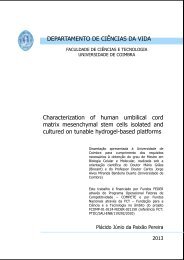role of th1 and th17 cd4+ t cell subsets in the pathogenesis of ...
role of th1 and th17 cd4+ t cell subsets in the pathogenesis of ...
role of th1 and th17 cd4+ t cell subsets in the pathogenesis of ...
You also want an ePaper? Increase the reach of your titles
YUMPU automatically turns print PDFs into web optimized ePapers that Google loves.
By mechanisms that are still not clearly understood, <strong>in</strong> MS <strong>and</strong> o<strong>the</strong>r autoimmune<br />
diseases, such as Type 1 Diabetes, Crohn´s disease or Rheumatoid Arthritis, <strong>the</strong> immune<br />
system recognizes self‐antigens <strong>and</strong> mounts an <strong>in</strong>flammatory response <strong>in</strong> a tissue‐<br />
specific manner, that is, <strong>in</strong> <strong>the</strong> organ where <strong>the</strong> autoantigen is expressed. In <strong>the</strong> case <strong>of</strong><br />
MS, <strong>the</strong> immune system reacts components <strong>of</strong> <strong>the</strong> myel<strong>in</strong> sheath, produced by <strong>the</strong><br />
oligodendrocytes, lead<strong>in</strong>g to axonal damage <strong>and</strong>, ultimately, to neuronal death.<br />
Though <strong>the</strong> etiology rema<strong>in</strong>s complex, it is generally believed that <strong>the</strong>re is an<br />
environmental <strong>and</strong> genetic contribution to <strong>the</strong> <strong>pathogenesis</strong> <strong>of</strong> MS. In <strong>the</strong> first case, <strong>the</strong><br />
geographical difference is a susceptibility factor, with Nor<strong>the</strong>rn European <strong>and</strong> American<br />
countries be<strong>in</strong>g <strong>the</strong> more affected. In addition, it was proposed that viral <strong>in</strong>fections, like<br />
<strong>the</strong> Epste<strong>in</strong>‐Barr virus, could trigger MS through <strong>the</strong> molecular mimicry mechanism but<br />
so far <strong>the</strong>re are no def<strong>in</strong>ite evidences. In <strong>the</strong> second case, genetic population studies<br />
have shown that MS prevalence is higher <strong>in</strong> people related to MS patients. Also, some<br />
susceptibility genes have been correlated with MS. The ma<strong>in</strong> genetic factor is <strong>the</strong> major<br />
histocompatibility complex class II (HLA), which <strong>in</strong>cludes <strong>the</strong> HLA‐DR <strong>and</strong> <strong>the</strong> HLA‐DQ<br />
genes, <strong>in</strong> particular <strong>the</strong> HLA‐DR15 haplotype <strong>in</strong> Caucasians encod<strong>in</strong>g <strong>the</strong> HLA‐DR alleles<br />
DRB1 * 1501 <strong>and</strong> DRB5 * 0101. HLA‐DR15 has been associated with <strong>the</strong> transform<strong>in</strong>g<br />
growth factor beta (TGFβ) family members, <strong>the</strong> cytotoxic T lymphocyte‐associated<br />
antigen 4 (CTLA‐4), <strong>and</strong> <strong>the</strong> tumor necrosis factor (TNF) cluster, among o<strong>the</strong>rs. IL‐7 <strong>and</strong><br />
IL‐2 cytok<strong>in</strong>es have also been identified as conferr<strong>in</strong>g susceptibility to <strong>the</strong> disease<br />
(Sospedra <strong>and</strong> Mart<strong>in</strong>, 2005;We<strong>in</strong>er, 2009). These facts have re<strong>in</strong>forced <strong>the</strong> importance<br />
<strong>of</strong> <strong>the</strong> <strong>role</strong> <strong>of</strong> <strong>the</strong> immune <strong>cell</strong>s <strong>in</strong> <strong>the</strong> <strong>pathogenesis</strong> <strong>of</strong> MS, <strong>in</strong> particular <strong>the</strong> CD4 + T<br />
lymphocytes which are activated by <strong>the</strong> antigen present<strong>in</strong>g <strong>cell</strong>s (APCs) <strong>in</strong> a HLA class II‐<br />
dependent manner. In a healthy <strong>in</strong>dividual, some T <strong>cell</strong>s can be found <strong>in</strong> <strong>in</strong>tact CNS but<br />
only those capable <strong>of</strong> react<strong>in</strong>g with a CNS antigen, by means <strong>of</strong> tolerance break, rema<strong>in</strong><br />
<strong>and</strong> trigger an autoimmune <strong>in</strong>flammatory response (Hickey et al., 1991).<br />
20

















